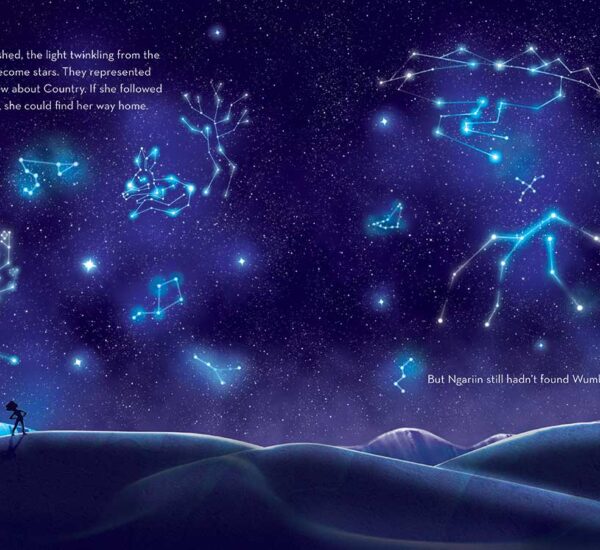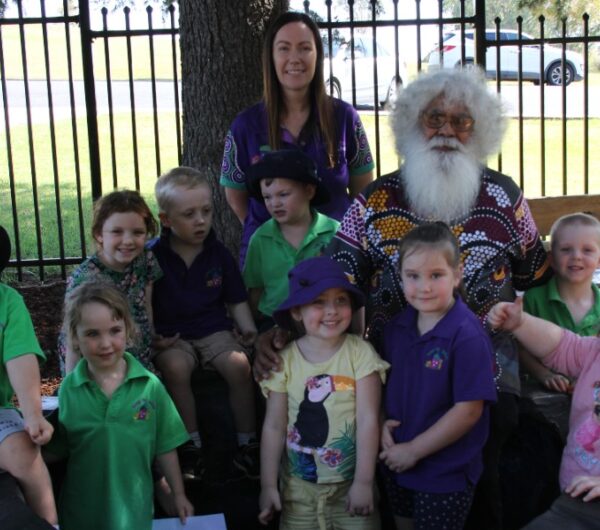“Can we see Glenn again?” – building a connection with the local Aboriginal community

In the piece below, Early Childhood Teacher Darren Halim from Highgate Early Learning Centre tells his story of making a meaningful connection with local Wiradjuri artist Glenn, and how a chance viewing of a painting in a cafe led the service on a deep journey of connection, friendship and learning.
Serendipity…and a cup of tea
The story begins with Darren’s coworker Julie, who was enjoying a visit to a local cafe, where some beautiful Aboriginal artwork was on display.
“She asked the owner who the artist was,” Darren said, “and they said it was painted by a local artist named Glenn. That was all the information we got. At the same time, I was researching local Aboriginal heritage sites in the City of Boroondara, and I saw one just 700m from our centre called The Wominjeka (Reconciliation) Garden located in St Oswald Anglican Church.”
Darren dug a little deeper, and soon learnt that the Reverend Glenn Loughrey was part of its history, and that he is also a Wiradjuri Artist.
“Julie and I matched the paintings we saw on his website with the ones at the café, and it was indeed by him. It was pure coincidence and serendipity. Julie strongly urged me to reach out to him, and I did,” Darren said.
“Before I emailed Glenn, I took the time to learn more about him, refine my intentions as to what am I actually seeking and to curate a respectful message. I am aware that Wiradjuri People are from central New South Wales, and the Land in which Highgate Early Learning Centre and The Wominjeka Garden are both part of the Wurundjeri Country. Hence, doing my research beforehand about both Aboriginal groups was vital, and even seeking to understand Glenn’s personal journey and story was one of our starting points in this partnership,” he continued.
“Glenn…agreed to meet us for a visit during Term 2 at The Wominjeka (Reconciliation) Garden.”
Term 2
During Term 2 the children and educators from the service went to visit the Garden, sitting in the meeting circle where Glenn shared some of his cultural artefacts as a Wiradjuri Aboriginal Man.
“He showed us tapping sticks, coolamon (traditional shopping basket or bassinet), and an emu caller,” Darren shared.
“We toured the Wominjeka Garden and learnt about the different native plants present all around the garden. Glenn explained to us the interesting repetitive circular shape of the garden to represent the significance of yarning circles as part of the Aboriginal culture.”
The children and educators were also given a tour inside the local gallery, housed in the church, and known as Murnong Gallery, where some of Glenn’s paintings are displayed.
“As an artist, Glenn heavily emphasised that he gets his inspirations from the land, what Aboriginal people call Country. Country is [viewed in a similar way to how we view] books, as knowledge comes from it, and his connection with Country is deep,” Darren shared.
Glenn also visited the three-year-old kindergarten children at Highgate ELC before Term 2 finished to talk about yarning circles and yarning sticks.
At the end of the term, Darren said he and the team “could see the blooming of this connection as it shows great potential and reciprocity”.

Wominjeka Garden at St. Oswald Anglican Church, Glen Iris
Term 3
In Term 3, the service’s four-year-old kindergarten program made a connection with Glenn and the garden through its Fire Lab program, using the fire pit at the Wominjeka Garden as an extension.
“We reached out to Glenn to see if he could assist us with the fire pit, and he said yes,” Darren shared.
“At our Fire Lab lessons, we learned about the danger of smoke, but Glenn explained how in his culture, smoke has the ability to cleanse things. We watched Glenn light up the fire and listened to his stories and anecdotes. There is something fascinating and alluring in watching fire.”
Next, we arranged a follow-up visit to use the fire pit to cook something, because we had been cooking corn kernels during our Fire Lab program. Glenn suggested cooking Johnny Cakes or Bush Scones. It was such a rich bonding experience for the children, educators, and Glenn.
These experiences translated back to the children’s play, with much of their imaginative play centreing on the theme of fire such as “cooking the fish in the fire” by using a tire to mark the bonfire.
Term 4
In the final visit for the year, Glenn invited the service to do some dot painting with him.
“Dot painting is Glenn’s method of painting, [using] the end of skewers for his painting,” Darren explained.
“He took us back to Murnong Gallery and explained his painting process and how it can take over 100 hours to complete a single painting. Some children were excited to come back to see the gallery as they have visited the gallery in the past with their families. Glenn and I reflected back on the year and I thanked him for his continual effort to make time for us, and share his knowledge with us.”
As with the fire, much of what the children learnt during their visit translated into their work and play back at the service, with some children using more dots and points in their work, moving from brush strokes to dots.
Reflecting on connection
“Creating a relationship with our local Aboriginal and/or Torres Strait Islander community is an important factor in building children’s awareness and understanding of Aboriginal and Torres Strait Islander culture and perspective in an authentic manner,” Darren said.
“It also sends a strong message to the children, families, and educators of how much our Kinder respects and values Aboriginal and Torres Strait Islander’s culture.”
From an educator perspective, Darren is thankful for having access to a direct source of learning, and a way to embed the Aboriginal and Torres Strait Islander culture into the program in a culturally sensitive manner, along with “a great self-reflective point of our own understanding of cultural competence”.
Building a partnership with Glenn required reciprocity, time, and collaboration. To support other services, Darren has shared “a couple of key aspects our team considered throughout our journey”:
- Understanding the local history: Taking the time to learn more about the local Aboriginal history at City of Boroondara, asking questions to Glenn and taking notes and connecting the pieces of information to understand the bigger picture, and sharing this insight with your co-educators. Educators are also highly encouraged to learn and recognise the continuing impact of the history and legacies of Aboriginal and Torres Strait Islander communities in today’s world (ACECQA, 2020).
- Linkages to your kindergarten program: It is imperative to establish links between the opportunity our visits with Glenn present with our current program to create an even richer and meaningful learning experience. At Highgate’s four-year-old kindergarten program, we run a weekly Bush Kinder and Fire Lab program that enables children to go on frequent outings, have first-hand experience with nature, and be involved in risky play. This turned out to be a great basis for the topics we explored with Glenn and the four-year-old kindergarten children as they share lots of similarities and room for extensions and provocations.
- Making the effort: It takes regular initiatives and respectful communication to build a strong partnership. I would always follow-up and schedule future visits with Glenn, send him a thank you email for his time and preparations, share with Glenn any relevant learning stories about our visit or the related extensions we do at kinder, and ask Glenn and his team if there is anything our kinder can help with. Any ideas that Glenn proposed, I would take note and try to implement and report back to him on how the children found it. The little things we do shows a great deal of the sense of respect and appreciation we have for the other party. It is important to be mindful of how as educators we utilise this authentic connection.
- It takes time: Building a partnership is a two-way street that takes time to build trust (ACECQA, 2020). Throughout the year, Glenn and our kinder have now been familiar with each party’s working styles and pattern of ideas. We have to be mindful of each other’s schedule, workload and priorities in creating times to visit each other, flexibility is needed. The four-year-old children in my room have also referred to Glenn often, as he becomes a regular and important educator as well in our small-knit community.
Popular

Workforce
Policy
Quality
Practice
Provider
Research
ECEC must change now, our children can’t wait for another inquiry
2025-07-02 07:47:14
by Fiona Alston

Practice
Provider
Quality
Workforce
Leading with Curiosity: How distributed leadership is redefining the future of early childhood education
2025-07-03 07:42:07
by Contributed Content

Events News
Workforce
Marketplace
Practice
Quality
Provider
Research
An exclusive “Fireside Chat” with ECEC Champion Myra Geddes
2025-07-01 11:25:05
by Fiona Alston













